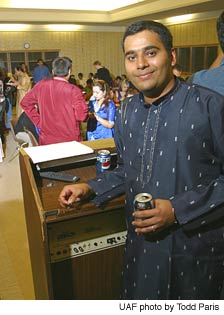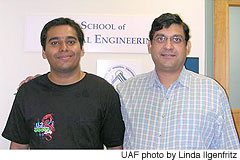UAF international student finds home away from home
January 2004
By Carla Browning, University Relations
Graduate student Neil D'Cunha left his culture and climate behind in Mangalore, India when he decided to pursue his master's degree in geological engineering. Just a year before his graduation from the National Institute of Technology Karnataka in 2002, he was introduced to the possibility of coming to America and attending the University of Alaska Fairbanks for his graduate degree.
"In the third year of my undergraduate degree, I had begun exploring various master's programs, but hadn't heard of UAF," said D'Cunha. "Just as I began my application process one of my professors suggested I apply, and I decided to go for it."
D'Cunha had only been at UAF for one year when he applied for and received a two-year, $65,000 subsurface science fellowship through the Inland Northwest Research Alliance, a consortium of eight western universities including UAF.
D'Cunha is researching enhanced methods of remediation, or clean-up, of contaminated groundwater at UAF's School of Mineral Engineering (SME).
"The research conducted here is excellent and there is absolutely a wealth of opportunities for graduate students interested in genuine research," D'Cunha said.
 Even with an abundance of academic opportunities, D'Cunha admits it was a big change
coming to Fairbanks from a semi-cosmopolitan community in southern India where the
average temperature from October to February is around 80 degrees F. He was a bit
apprehensive in the beginning but now says he feels right at home.
Even with an abundance of academic opportunities, D'Cunha admits it was a big change
coming to Fairbanks from a semi-cosmopolitan community in southern India where the
average temperature from October to February is around 80 degrees F. He was a bit
apprehensive in the beginning but now says he feels right at home.
"The climate of Alaska was a constant worry for me until I actually experienced winter," said D'Cunha. "But I found it was absolutely no trouble as long as I had warm clothes. The best feeling I ever get about Alaska is when my flight lands in Fairbanks. I get the feeling that I have reached home."
One reason D'Cunha feels at home at UAF is that he's not alone. As of fall 2003, there were more than 250 international students at UAF, about 100 of those in engineering programs. Out of the 98 international students in engineering, nearly two-thirds are from India. The number of Indian students in Fairbanks is likely to increase as UAF signed a memorandum of understanding in 2003 with India's University of Pune to formalize a student-faculty exchange program.
"Our students and faculty benefit from expanded opportunities to pursue common interests with colleagues from all points on the globe," said UAF Provost Paul Reichardt. "Because of the quality of our programs we were able to add a Ph.D. in engineering in 2001. The advanced degree will help us meet the needs of our students both in the state and around the world."
D'Cunha plans to complete his Ph.D. in 2007 and eventually teach at the Indian Institute of Technology. He credits his scholastic success to Debasmita Misra, his faculty advisor in UAF's geological engineering department.
"I found graduate school a little difficult the first semester, but my advisor helped me to get over my initial challenges," said D'Cunha. "He changed the way I look at things, and his support has motivated me to do my best."
For more information on UAF's International Programs visit the website at https://uaf.edu/isss/.

D'Cunha finds social activities with other Indian students and community members through
the student group on campus, " Namaste India." Indian students accounted for 31 percent
of the international student population in fall 2003, the largest international group
on campus.

The Duckering Building is a modern engineering center for the 21st century. Home to
all of UAF's engineering instructional and research programs, including the Institute
of Northern Engineering, the Mineral Industry Research Laboratory and the Petroleum
Development Laboratory.

D'Cunha with his advisor Debasmita Misra.
![]()
Many international students look to other UAF students for information before moving to Alaska. One of the best places for that information is on the student-created Namaste India website located at asuaf.org/~ganga_ind/.
What is Namaste?
It is a manner of greeting used by many Hindu, Taoist and Buddhist as a form of reverence.
Commonly written "Namaste", it is pronounced as "Namastay." The Sanskrit word Namaste
means,
"I bow to the divine in you."


